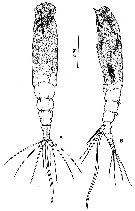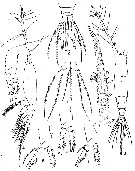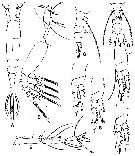|
|
 |
|
Monstrilloida ( Order ) |
|
|
|
Monstrillidae ( Family ) |
|
|
|
Monstrilla ( Genus ) |
|
|
| |
Monstrilla spinosa Park, 1967 (F,M) | |
| | | | | | | Ref.: | | | Park, 1967 (p.150, figs.F,M); Shih & al., 1971 (p.157); Gardner & Szabo, 1982 (p.88, figs.F,M); Grygier, 1995 a (p.76); Suarez-Morales & Vasquez-Yeomans, 1996 (p.288, figs.F); Suarez-Morales, 2011 (p.8, 10) |  issued from : E. Suarez-Morales & R. Vasquez-Yeomans in Crustaceana, 1996, 69 (3). [p.290, Fig.1A, B]. Female (from bahia de Todos Santos, Baja California): A-B, habitus (dorsal and lateral, respectively).. Scale in mm. Nota: Presence of a prominent ventral rostrum between the bases of the two antennules ( this kind of ventral prominence is not common throughout the monstrillids group). Relative size of A1, which are almost as long as the body), the distal 2/3 of segments show a densely pitted surface and a series of circular ridges (annulated aspect). 2nd and 3rd thoracic segments with a pair of consspicuous dorsal spiniform processes. Cephalic somite and incorporated thoracic somite drnsely pitted, with several ridges of cuticular processes.
|
 issued from : E. Suarez-Morales & R. Vasquez-Yeomans in Crustaceana, 1996, 69 (3). [p.291, Fig.1C, D]. Female: C, right A1 (distal portion; dorsal view); D, left A1 (dorsal view).
|
 issued from : T.S. Park in Trans. Amer. Microsc. Soc., 1967, 86 (2). [p.148, Fig.4]. Female (from Strait of Georgia): A-B, habitus (lateral and dorsal, respectively); C, posterioir portion of body (ventral); D, distal portion of A1; E, P1; F, P2; G, P3; H, P4; I, P5.
|
 issued from : T.S. Park in Trans. Amer. Microsc. Soc., 1967, 86 (2). [p.151, Fig.5]. Male: A-B, habitus (dorsal and lateral, respectively); C-D, posterior portion of body (lateral and ventral); E, A1; F-I, P1 to P4.
| | | | | Compl. Ref.: | | | Suarez-Morales & Gasca, 1998 a (p.112); Galbraith, 2009 (pers. comm.) | | | | NZ: | 2 | | |
|
Distribution map of Monstrilla spinosa by geographical zones
|
| | | | Loc: | | | British Columbia (Georgia Strait), NW Baja California | | | | N: | 3 | | | | Lg.: | | | (746) F: 2,87; M: 1,5; (760) F: 1,76-1,49; {F: 1,49-2,87; M: 1,50} | | | | Rem.: | Coastal, hyperbentic.
For Park (1967, p.151) this species is very distinctive because of its prominent rostrum and the spiniform processes on the 2nd and 3rd metasomal segments.
According to Suarez-Morales & Vasquez-Yeomans (1996, p.293) the observed differences between the original description ( based only from a single specimen of each sex in the Strait of Georgia by Park, 1967) and the Bahia de Todos Santos form, could be the effect of latitudinal morphological variation within the species (13 latitudinal degrees). The specimens are at least 2.5 times smaller that the designated holotype from the Strait of Georgia (Park, 1967). In the female holotype specimen, A1 represent 0.86 of the total body length (from the top of the cephalic somite to the end of the caudal rami), while this value is 0.68-0.71 in the Bahia de Todos Santos' specimens; the dorsal and ventral surface of the cephalic somite and incorporated thoracic somite are densely pitted, with several ridges of cuticular processes (this feature is mentioned in the original description only for the surface of A1, which is not pitted in the Bahia de Todos Santos' specimens); on the distal end of the terminal antennular segment, the holotype shows 2 strong spines and 1 subterminal, small seta; these 3 structures are absent in the Bahia de Todos Santos' material (apparently as a result of fixation and/or handling). | | | Last update : 20/01/2015 | |
|
|
 Any use of this site for a publication will be mentioned with the following reference : Any use of this site for a publication will be mentioned with the following reference :
Razouls C., Desreumaux N., Kouwenberg J. and de Bovée F., 2005-2025. - Biodiversity of Marine Planktonic Copepods (morphology, geographical distribution and biological data). Sorbonne University, CNRS. Available at http://copepodes.obs-banyuls.fr/en [Accessed December 31, 2025] © copyright 2005-2025 Sorbonne University, CNRS
|
|
 |
 |







